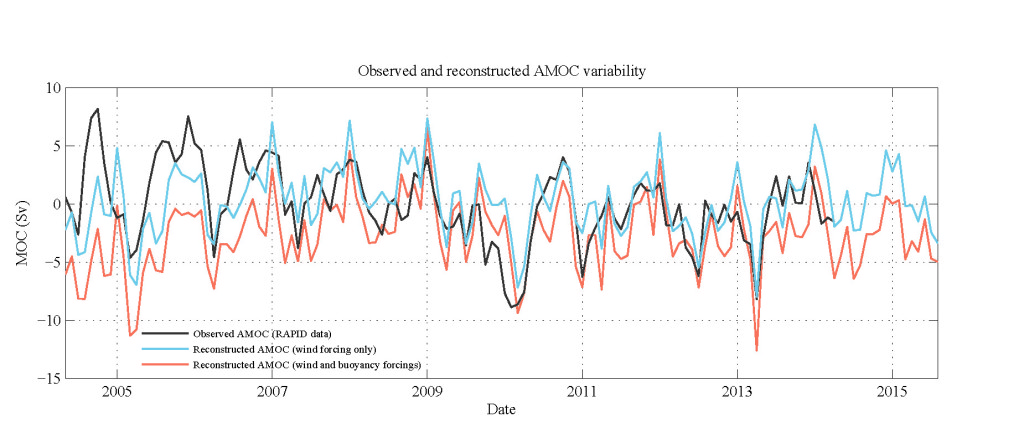by Helen Johnson, Helen Pillar, David Marshall and So Takao
 Since 2004, oceanographers from the National Oceanography Centre in Southampton, together with US colleagues, have been using data from ocean moorings on the eastern and western sides of the Atlantic Ocean at 26 N to monitor the strength of the Atlantic meridional overturning circulation (AMOC). This has resulted in a remarkable and unprecedented 10 year timeseries of this key climate index (black line), which is closely related to ocean heat transport in the Atlantic and, as such, of great importance for the climate of western Europe as well as the entire globe. The observations have revealed large amplitude variations in the AMOC on all time-scales, along with an apparent decline over the ten years, and significant wind-driven weakenings in several recent winters. This autumn the team will collect a further 18 months of data from their ocean moorings. But what will this latest batch of data tell us about the strength of the AMOC?
Since 2004, oceanographers from the National Oceanography Centre in Southampton, together with US colleagues, have been using data from ocean moorings on the eastern and western sides of the Atlantic Ocean at 26 N to monitor the strength of the Atlantic meridional overturning circulation (AMOC). This has resulted in a remarkable and unprecedented 10 year timeseries of this key climate index (black line), which is closely related to ocean heat transport in the Atlantic and, as such, of great importance for the climate of western Europe as well as the entire globe. The observations have revealed large amplitude variations in the AMOC on all time-scales, along with an apparent decline over the ten years, and significant wind-driven weakenings in several recent winters. This autumn the team will collect a further 18 months of data from their ocean moorings. But what will this latest batch of data tell us about the strength of the AMOC?
At the University of Oxford, we have been working to reconstruct the time-series of AMOC variability, based on our knowledge of how winds, heat and freshwater fluxes over the Atlantic have changed over the last few decades, combined with our understanding of how sensitive the AMOC is to variations in these quantities. We use an ocean model and its adjoint to determine the sensitivity of the AMOC to surface wind, heat and freshwater forcing over the entire globe and the preceding 15 years. We then project observed forcing anomalies onto these sensitivity patterns; only those forcing anomalies which project strongly in space and time onto the sensitivity fields will generate variability in the AMOC.
Our reconstructed AMOC time series (orange line) successfully reproduces most of the interannual variability in the observed AMOC time series; these short-timescale fluctuations are dominated by wind forcing (including, but not limited to, Ekman transport anomalies). However, the decadal trend in the observed AMOC time series is not well captured by our reconstruction. This longer timescale variability results from the integrated response of the ocean to heat fluxes over the subpolar North Atlantic over at least the last two decades, and as yet ocean models are unable to accurately represent the ocean’s adjustment to forcing anomalies on such timescales.
Since NCEP II reanalysis atmospheric forcing data is available until June 2015, our reconstructed AMOC time series extends 15 months beyond the end of the currently available observed AMOC time-series. We have reasonable confidence in that portion of the variability which is wind-driven (blue line). We therefore “predict” that the RAPID team will discover that the mean AMOC over this period has been roughly equal to that over the previous few years (a small increase of 0.3 ± 0.2 Sv over the 2009-2014 mean). We further predict that the RAPID data won’t reveal any evidence of a large “dip” over the 2014-2015 winter; in contrast we expect to find that the AMOC reached a maximum in November-January.
These predictions will be validated when the RAPID team publish their updated AMOC time-series early in 2016! And as RAPID data continue to accrue, alongside observations from higher latitudes such as those made by the OSNAP programme, we will learn more about the climatically-important longer-term AMOC changes which are currently inaccessible via our reconstruction – watch this space!
View as PDF: RAPID_prediction
0 responses to “What will the RAPID team find when they recover their ocean moorings this autumn?”